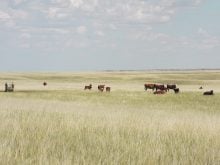Weed control is a particular issue, so competitive varieties should be selected and planted where weeds aren’t a problem
Cattle producers who are considering seeding polycrops for a winter feed source should start small to see if they are a good fit on their operation.
University of Saskatchewan master’s student Jacqueline Drieschner conducted a two-year study that found some potential pluses and minuses in growing the seed mixtures.
She compared a polycrop of hairy vetch, crimson clover, forage peas, Italian ryegrass, sorghum and three forage brassicas: winfred, hunter and graza to barley swath grazing.
Drieschner looked at yield, feed quality, soil organic carbon, seed cost, and grazing days.
Read Also

Charges laid after cattle theft
Saskatchewan RCMP lay two charges against a man after six cattle went missing.
One of the main problems in the polycrop was weed pressure.
“The biggest take-home message is, when you are considering using a polycrop, weed control is something that you want to think about,” she said. “In a polycrop like we grew you cannot use an in-crop herbicide because of the species mixture. You’ll kill something within the mixture.”
She said producers should pick fields where they don’t have weed issues, and choose forage species that can compete.
She noted that she tested a mixture that, at the time of the study in 2017 and 2018, was sold quite a bit, and that producers would likely question why she didn’t have a cereal in the mix.
Drieschner said she didn’t want to compare barley swath grazing with barley in a polycrop. Ideally, there would have been a third treatment but she said this way she was better able to pinpoint how the other species in a polycrop do.
“In northwest Saskatchewan, polycrops with (barley) together do really well. It’s definitely something to consider and something I get questions about all the time,” she said.
Another recommendation following her research is to make sure producers always test their feed. The brassicas in the mixes will lead to higher sulfur levels; those levels shouldn’t be higher than .5 percent.
Most prairie water sources have sulfur, too, and Drieschner said when the two are combined the levels can become too high.
Also watch for nitrates in feed because the brassicas take up nitrogen, which can mean higher levels.
Drieschner also said mineral packages can be different when using polycrops.
“We always want a greater than 1.5:1 calcium to phosphorus ratio,” she said. “With these polycrops, they did have quite a bit higher calcium than the barley does. In my particular mixture you would have been able to get away with a cheaper mineral, a 1:1 mineral instead of a 2:1 mineral because you were able to balance out the cattle needs with the way that these plants accumulate calcium in an available form for cattle.”
The crude protein in the mix was 14 percent, compared to 10 percent in barley.
Polycrop seed mixes are more expensive than barley seed alone. In Drieschner’s study, the grazing cost per cow per day was $1.35 higher in the polycrop because it yielded so much less under the weed pressure and resulted in 27 fewer grazing days.
“It does cost quite a bit more but theoretically speaking, and from my anecdotal experience, your polycrops with a cereal mixed in do yield better than barley alone,” she said. “With that increase in biodiversity and different plants’ ability to compete for resources in different ways you usually get an increased yield potential. If you had a higher yield, even if the seed costs more, it would pencil out closer.”
In terms of soil organic carbon, Drieschner said the study found that polycrops were beneficial and increased carbon in degraded upslope locations at depths of five to 20 centimetres.
“What’s really significant about this is that two years is such a short period of time,” she said.
Drieschner, who works as a business agronomist at Cavalier Agrow Ltd./Gmac’s Ag Team in Spiritwood, Sask., while she is finishing her thesis, said producers who want to try polycrops should start with a small acreage, perhaps 20 acres, and see how they do. Species in the polycrops are often warm season grasses and may not do well in all regions.


















